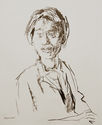
19th, 20th & 21st Century Fine Prints
707-546-7352 · fax 707-546-7924 · web: www.annexgalleries.com · email: artannex@aol.com
Oskar Kokoschka Biography
Oskar Kokoschka
German
1886–1980
Biography
Oskar Kokoschka was born on March 1, 1886 at Pöchlarn on the Danube, Austria. His father, Gustav Kokoschka, who was trained as a goldsmith, came from Prague, and his mother, Romana Loidl, originally from Styria. She was an imaginative storyteller, and she inspired early Kokoschka's love of nature. After graduating from a state school he went to Vienna where he studied at the Vienna School of Arts and Crafts from 1905 to 1909. The revolutionary nature of his art caused much debate and even led to his dismissal from the Art School after he drew a poster, a pietá with a bloody man.
In 1907 Kokoshka worked at the Wiener Werkstätte (Vienna Workshops) and collaborated in founding the Cabaret Fledermaus. The Vienna Workshops published Kokoschka's Die Träumenden Knaben (1908, The Dreaming Youth), which showed the influence of Gustav Klimt (1862-1918).
Kokoschka participated in the Internationale Kunsstchau in 1908 and 1909, when he exhibited the portrait of the actor Ernst Reinhold, and illustrations for the poem Der Weisse Tiertöter, later entitled Der Gefesselte Kolumbus (1916). In 1911 he was appointed assistant teacher at the School of Arts and Crafts in Vienna.
During World War I Kokoschka served in the cavalry - he volunteered partly to end his love affair with Alma Mahler. In August 1916, he suffered shell-shock and recovered in the hospital.
In 1917 he spent some time in Stockholm and Dresden, where he became the centre of a bohemian group of writers and actors. During this chaotic period of the late 1910s he was known as "mad Kokoschka." At the Dada Gallery in Zürich he held an exhibition with Max Ernst, Paul Klee, and Kandinsky. His lithographs were shown at the Cassirer Gallery in Berlin and in 1918 appeared his book Vier Dramen, which Cassirer had brought together. Kokoschka’s cooperation with him had started already in 1910.
In Munich his paintings were shown at an exhibition entitled Entartete Kunst (degenerate art), and soon removed from public collections. In 1938 he fled with Olda Palkovská on the last plane out of Vienna to London; they married in 1941 in an air-raid shelter. During the war Kokoschka also spent much time in Cornwall and Scotland. His works were shown in the United States in New York, Chicago, and Springfield at the Museum of Fine Arts. The fascist government banned Michelangelo Masciotta's monograph on his work.
After the war his graphic works were shown in Vienna. Kokoschka had been invited to participate at the Venice Biennale already in the 1920s, and at the XXIV Biennale in 1948 there was a special exhibition of his works. In 1953 he taught first time at the Internationale Sommerakademie für bildende Kunst at Salzburg, where he worked also as a designer for the theatre. Eventually he settled with his wife Olda in Villeneuve on the lake Geneva, Switzerland.
Kokoschka died on February 22, 1980, in Montreux, Switzerland.

